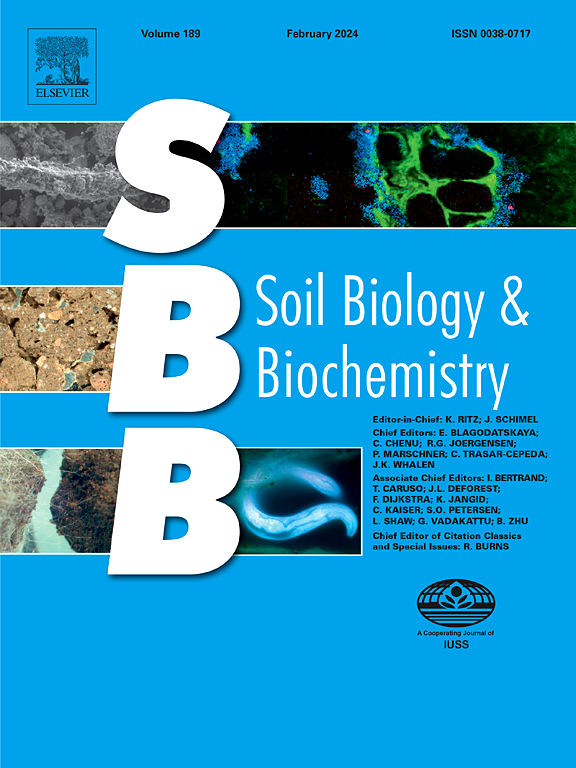Very fine roots differ among switchgrass (Panicum virgatum L.) cultivars and differentially affect soil pores and carbon processes
IF 9.8
1区 农林科学
Q1 SOIL SCIENCE
引用次数: 0
Abstract
Switchgrass (Panicum virgatum L.) is a promising feedstock for biofuel production, with diverse cultivars representing several ecotypes adapted to different environmental conditions within the contiguous USA. Multiple field studies have demonstrated that monoculture switchgrass cultivation leads to slow to negligible soil carbon (C) gains, an outcome unexpected for such a deep-rooted perennial. We hypothesize that different switchgrass cultivars have disparate impacts on soil C gains, and one of the reasons is variations in physical characteristics of their roots, where roots directly and indirectly influence formation of soil pores. We tested this hypothesis at Great Lakes Bioenergy Research Center's research site in Michigan using two lowland cultivars (Alamo and Kanlow) and four upland cultivars (Southlow, Cave-in-Rock, Blackwell, and Trailblazer). Three types of soil samples were collected: 20 cm diameter (Ø) intact cores used for root analyses; 5 cm Ø intact cores subjected to X-ray computed tomography scanning used for pore characterization; and disturbed soil samples used for microbial biomass C (MBC) and soil C measurements. Path analysis was used to explore interactive relationships among roots, soil pores, and their impact on MBC, and ultimately, on soil C contents across six cultivars. The abundance of very fine roots (<200 μm Ø) was positively associated with fractions of pores in the same size range, but negatively with distances to pores and particulate organic matter. Higher abundance of such roots also led to greater MBC, while greater volumes of medium pores (50–200 μm Ø) and shorter distances to pores increased MBC. Results suggest that the greater proportion of very fine roots is a trait that can potentially stimulate soil C gains, with pore characteristics serving as links for the relationship between such roots and C gains. However, at present, ten years of cultivation generated no differences in soil C among the studied cultivars.
开关草(Panicum virgatum L.)不同栽培品种的细根对土壤孔隙和碳过程有不同影响
开关草(Panicum virgatum L.)是一种很有前景的生物燃料生产原料,其栽培品种多种多样,代表了美国毗连地区适应不同环境条件的几种生态型。多项实地研究表明,单一种植开关草会导致土壤碳(C)的缓慢增加,甚至可以忽略不计,对于这种深根多年生植物来说,这种结果是出乎意料的。我们假设,不同的开关草栽培品种对土壤碳增量的影响不同,原因之一是其根系的物理特性不同,根系直接或间接影响土壤孔隙的形成。我们在密歇根州大湖生物能源研究中心的研究基地使用两个低地栽培品种(阿拉莫和坎洛)和四个高地栽培品种(南洛、岩洞、布莱克威尔和开拓者)对这一假设进行了测试。采集了三种类型的土壤样本:用于根系分析的直径为 20 厘米(Ø)的完整土芯;用于孔隙特征描述的经过 X 射线计算机断层扫描的直径为 5 厘米(Ø)的完整土芯;以及用于微生物生物量 C (MBC) 和土壤碳测量的扰动土壤样本。利用路径分析探讨了根系、土壤孔隙之间的交互关系,以及它们对微生物生物量C的影响,并最终影响了六个栽培品种的土壤C含量。极细根系(直径 200 微米)的丰度与相同大小范围的孔隙比例呈正相关,但与孔隙距离和颗粒有机物呈负相关。此类根的数量越多,中型气孔(直径 50-200 微米)的体积越大,与气孔的距离越短,中型气孔的体积就越大。研究结果表明,较多的细根有可能促进土壤碳的增加,而孔隙特征则是细根与碳增加之间关系的纽带。然而,目前,十年的栽培并未在所研究的栽培品种之间产生土壤碳的差异。
本文章由计算机程序翻译,如有差异,请以英文原文为准。
求助全文
约1分钟内获得全文
求助全文
来源期刊

Soil Biology & Biochemistry
农林科学-土壤科学
CiteScore
16.90
自引率
9.30%
发文量
312
审稿时长
49 days
期刊介绍:
Soil Biology & Biochemistry publishes original research articles of international significance focusing on biological processes in soil and their applications to soil and environmental quality. Major topics include the ecology and biochemical processes of soil organisms, their effects on the environment, and interactions with plants. The journal also welcomes state-of-the-art reviews and discussions on contemporary research in soil biology and biochemistry.
 求助内容:
求助内容: 应助结果提醒方式:
应助结果提醒方式:


